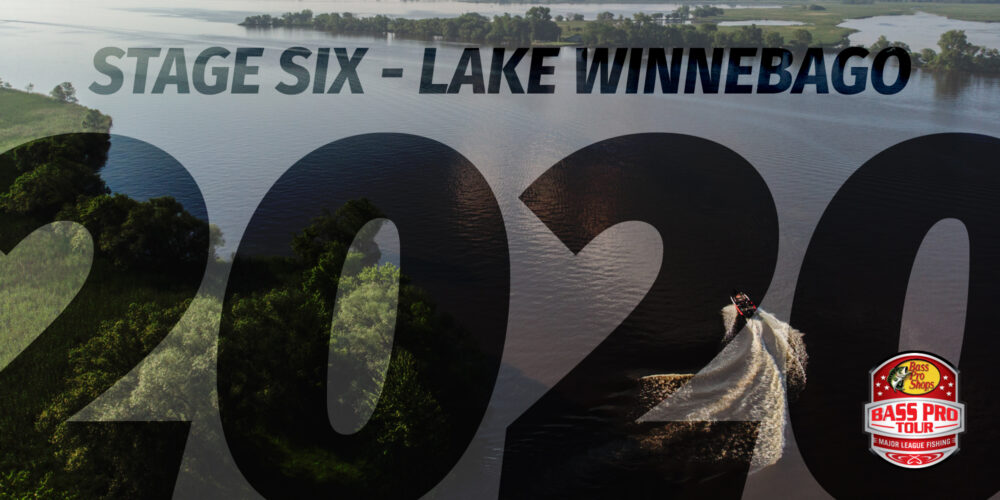BASS PRO TOUR 2020: Expect Smallmouth to be Bigger Players in Stage Six Return to Neenah

NEENAH, Wis. – When a fishery (or in this case, fisheries) gets put on the schedule for a consecutive season, at the exact same time as the previous year, pros should know what to expect.
That really won’t be the case for Stage Six of the 2020 MLF Bass Pro Tour.
Yes, the Stage will be held June 5-10, 2020 on the same Wisconsin fisheries of Lake Winnebago, Lake Butte des Morts and Green Lake as it was last year. But if Mother Nature offers even a smidge better conditions (which shouldn’t be hard compared to 2019), then the 80 MLF pros should find a host of untapped opportunities awaiting for them in the land of cheese and cows.
“Assuming we get better weather, I think you’ll see both species (largemouth and smallmouth) be much bigger players (than in 2019, when largemouth dominated),” says Cliff Pace, who won the Neenah event in 2019.

Wind-Blown Browns
When you head north to fish for bass, usually you do so to chase smallmouth.
And why wouldn’t you? With apologies to the Ozark reservoirs or those in Kentucky or Tennessee, the brown-fish fisheries up north are arguably the best in the country.
Yet, anyone watching Stage Eight of 2019 might have noticed something: a particular lack of smallmouth being caught. That wasn’t an indictment of the brown-fish populations in the three lakes but more a product of the conditions.
The pros were pounded by 30 mph winds throughout practice for Stage Eight in 2019, which meant any practice was spent hunkered up shallow, out of the gusts. Thus, pros weren’t able to ever spend much (if any) time offshore looking for smallmouth.
“Being unable to spend any time out deep during practice, guys were kind of forced to fish up shallow (during the event),” says Pace. “You didn’t want to waste time during a round looking and trying to find smallmouth. Largemouth were just easier.”
Tight Quarters
At 137,700 acres, Lake Winnebago is one of the largest natural inland lakes in the U.S. Yet, because anglers were corralled into the same shallow areas in practice by the wind, it and the rest of the fisheries in the subsequent rounds fished quite small, according to Pace.
“We were all fishing on top of one another because we all were trying to get out of the wind,” says Pace.
Thus, if there is one thing Pace is most excited about for 2020, it’s the potential for both species to be in play to help spread the field out.
“I’d be happy about (the field spreading out) and everyone having more room to fish,” says Pace. “We could actually run around, and I think you’ll see the smallmouth play a lot stronger.”

What to Expect June 5-10, 2020
Stage Six will be one of two Stages in 2020 where the anglers will compete on three different fisheries depending on the round (Stage Four is the other, on Jordan Lake, Falls Lake and Shearon Harris Reservoir in North Carolina).
And when you deal with three fisheries, you’re dealing with constantly needing to adapt, as Pace did in 2019. He got through the Shotgun Round on Winnebago using a balsa squarebill crankbait, then flipped on Butte des Morts in the Elimination Round before relying on a jerkbait on Green Lake to secure the victory.
“All three are your typical northern lakes, but they’re all very different,” says Pace.
Winnebago is the biggest and may offer the best opportunities for anglers to go after either species. It not only has seemingly endless offshore humps and reefs for smallmouth, but as the pros found out in 2019, it has plenty of shallow vegetation and docks for largemouth.
Yet, as Pace had to do, making it past the big lake means more than likely having to shift gears. Butte des Morts is connected to Winnebago by the Wolf River, but the majority of its 8,800 acres is flooded marshland. In other words, prime largemouth habitat.
And then there is Green Lake, which happens to be the deepest natural inland lake in the state, with a maximum depth of 237 feet and an average depth of 100 feet. Deep and clear equals smallmouth again, though, obviously, Pace did just fine in 2019 with largemouth.
“It should be another good event,” says Pace. “The fishing, the community; it will all be great, and obviously, Winnebago will always have a special place in my heart after (2019).”